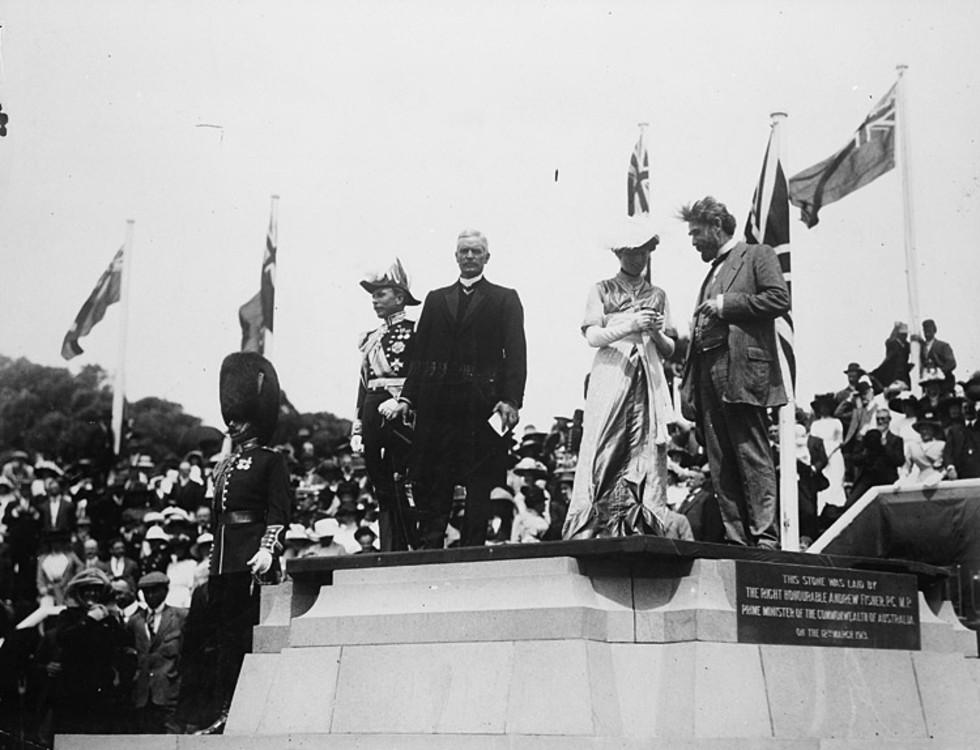


About this record
This is a black-and-white photograph showing the ceremony on 12 March 1913 for the naming of the new federal capital of Australia, which Lady Denman formally named Canberra. It shows Lady Denman, her husband Governor-General Lord Denman, Prime Minister Andrew Fisher and the Minister for Home Affairs, King O'Malley, standing on a dais placed over newly laid foundation stones. A crowd of people can be seen in the background and a traditional King’s Guard can be seen to the left of the dais. Several flags, including the Union Jack, are flying.
Educational value
- This photograph shows a key moment in Australia's history – the naming of the new federal capital. The significance of this event is obvious from the presence of the most important political figures of the day: the Prime Minister and the Governor-General. Lady Denman, the Governor-General’s wife, officially announced the capital's name. The construction of Canberra had begun on 20 February 1913 and this was the foundation ceremony for the new capital.
- It was at this ceremony that the name 'Canberra' was formally announced for the first time. A competition had been held to decide on the capital's new name, with the winning choice being Canberra. The district was already known by this name, derived from the Ngunnawal/Kamberri people whose country it is. The European pronunciation was decided when the official version was announced by Lady Denman at the foundation ceremony. Her pronunciation was with the emphasis on the first syllable.
- The photograph also shows the Minister for Home Affairs, King O'Malley (c1858–1953), at the ceremony during which he laid the third foundation stone, after the Governor-General Lord Denman and Prime Minister Andrew Fisher had laid the first two. These stones were intended as the base of a Commencement Column, which would be the centre of a People’s Park. O’Malley was one of Australia's most flamboyant and controversial politicians, known for flashy dressing and radical ideas. He was prominent in the selection of the site and planning for the new city, holding firm opinions, which at times led to arguments.
- Over 4000 spectators watched the proceedings, including some 500 invited guests who arrived on special trains from Melbourne and Sydney to be part of the day's events. The invited guests were seated on specially made stands. While the population of Canberra in 1911 was only 1714, it swelled to more than 5000 people on the day. Since there were few existing buildings, guests stayed in nearby Queanbeyan or returned home by train that evening.
- Before Lady Denman named the city, three foundation stones had been laid as a base for the planned Commencement Column on Capitol Hill (now Capital Hill) named by Walter Burley Griffin (1876–1937), and intended as the site of the Capitol building where important state events would be held. This building, the Column and the proposed park were never built. The foundation stones were moved to Federation Mall before the present Parliament House was opened in 1988.
- Although this ceremony took place in 1913 it was not until the 1920s that construction of the city proceeded. The most important public building, Parliament House, was completed in 1927. The outbreak of World War I in 1914 diverted resources and time away from the building of Canberra. Construction plans were also stalled with the onset of the Great Depression in 1929 and then in 1939 with the outbreak of World War II.
Acknowledgments
Learning resource text © Education Services Australia Limited and the National Archives of Australia 2010.
Related themes
Need help with your research?
Learn how to interpret primary sources, use our collection and more.



